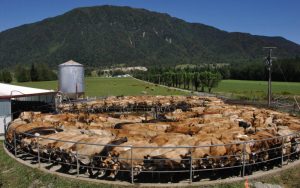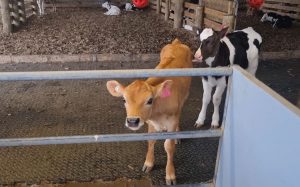
The South Island exposed them to just how beautiful things are and how much diversity in land-use there is.
That trip inspired them to begin searching for land to turn into their own piece of paradise. An acre or two spare in Wellington was rare, however, they didn’t have to look too far for that dream piece of land. They discovered a 43-hectare property in Brooklyn, only 15 minutes from Wellington’s bustling CBD.
“Our land has a deep history in sheep, beef and goats and was home to an Ayrshire dairy herd that supplied milk in glass bottles to the Brooklyn community for almost a century,” Frans says.
“Following that it was intermittently grazed as a sheep and beef station until fibre goats were farmed in the 1970-80s.
“After the 1987 sharemarket crash, the gates were opened and the goats were released into the surrounding hills, much to the disgust of the local council. When we bought the property it consisted solely of 18 years of regenerating farmland,” he says.
The couple were operating their construction business in October of 2016 when a Country Calendar episode featuring Kaikoura Cheese piqued their interest in farming goats for milk production. Soon after, they drew up a five-year plan to transition from construction to caprines.
“We hadn’t initially considered goat milk, but we thought it looked pretty cool. Given we’d bought bare land, we had to discover whether we could establish a farm here,” he says.
The council doesn’t want this land developed for housing, and for good reason; its unique location means it can be thought of as “a lung of Wellington,” Naomi says.
“We needed to be able to easily deliver a fresh, local product. It can be difficult having a very good product if you live a distance from your market. We’re only 15 minutes from New Zealand’s second-biggest city, with half a million people at our doorstep,” she says.
Getting started wasn’t easy and when they told their bank about the goat milk creamery, the first question they were asked was “what’s a goat milk creamery?”.
Since it was bare land, they had to set everything up from scratch.
In 2017 they built and installed the infrastructure, including power, fencing, barns, yards, shelters and a bridge allowing access from the road by car before building their home.
“We put in the first fencing around 6.07 hectares, which included the house. There’s scope to bring more land into production. But we farm our land differently because goats are browsers, not grazers,” Frans says.
A loafing barn is available 24/7 for the herd to use, especially during inclement weather and they constantly feed hay and baleage in the barn. Rainwater caught and stored in a tank automatically fills the troughs and mineral supplements are available at all times for the goats to essentially self-medicate.
“If a goat’s in really good condition she’ll easily produce between six to eight litres of milk per day. When you consider that a goat is an animal of around 55-60kgs, and how little they eat in comparison to a dairy cow, it’s a very good conversion rate,” Naomi says.
The farm is relatively high input, so they don’t have concerns about the location nor do they rely heavily on pasture, or the impacts of rainfall and other climatic conditions.
“Every season, we pre-purchase organic baleage and hay from Wairarapa and have worked with Fodder NZ to implement a hydroponic system to grow barley fodder for the goats. We get about a 15cm growth of barley in six days, supplementing 14% DM (120kg wet) per day,” Frans says.
“A custom goat feed pellet is made for us that matches their requirements for our farm. We supplement that feed with sprouted barley and ad-lib hay and baleage.”
Naomi’s experience in implementing complex employment policies and health and safety protocol changes for their construction company helped her navigate the MPI regulations.
“We discovered that MPI had developed RMP templates that even told us the milk’s shelf life. If you followed the templates, and didn’t try to reinvent the wheel, it became a relatively straightforward procedure,” she says.
“All the rules are in place to ensure that the milk is safe.”
They bought 12 goats in 2017 without really realising what they were getting themselves in for. They now farm around 80 goats and usually milk 60, with the balance being their own bred bucks and young stock.

“We were milking four goats at a time with a mobile quad milker. In May 2020 we ordered a $60,000 milking machine from Greece specifically made for 12 goats at a time. But due to covid delays it never arrived until Christmas,” she says.
They now have an on-site pasteurising system, refrigerated truck and a wash plant for the bottles. Milk is heat treated on-farm before rapidly chilling it to lock in the quality and taste.
Despite many people thinking it to be normal, goat milk shouldn’t taste “goaty”. If it doesn’t taste creamy and sweet, it’s due to the goat not having been fed correctly, or there are milk handling issues occurring.
“It was very exciting to sell our first milk in December 2021, and to once more supply the local Brooklyn community with milk from this property. In a way it’s gone full circle,” she says.
They sell their milk in Wellington on Saturday at the Thorndon Farmers’ Market, and on Sunday at the Harbourside Market and sell to cafés, restaurants and gelato manufacturers, and are stocked in Moore Wilson’s, Commonsense Organics, delicatessens and other retail outlets. The milk is usually delivered to town on the day it’s produced.
“We’ve launched branded one-litre glass bottles. The customer buys into the cost of the bottle in addition to the milk. Thereafter, they only pay for the milk component and the bottle is swapped each time,” she says.
“It’s a true circular economy and our milk is a product with a solution. Returned bottles are washed and sanitised in our purpose-built facility. We use zero waste shot glasses for our market tastings. The tastings break down people’s preconceptions about the flavour of goat milk.
“Wellington is one of the ‘foodie capitals’ of New Zealand and people are on board with the rinse and return for reuse milk-in-glass-bottle system we operate under, and are delighted to have access to a local, fresh milk supply.”





















